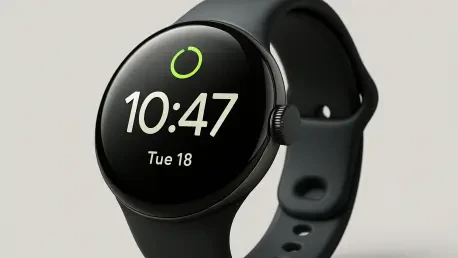In a world where smartwatches have become an extension of personal style and health, imagine a device so visually captivating that it stops strangers in their tracks, yet so frustrating in its functionality that it leaves users questioning their choice. Enter Google’s latest wearable, a smartwatch that promises to rival the giants of the industry with its sleek design but struggles to keep pace in the software race. This piece dives deep into the allure and the aggravations of this much-talked-about gadget, exploring whether it can truly stand as a game-changer for Android loyalists seeking a premium experience.
Why This Smartwatch Stands Out in a Crowded Market
The significance of Google’s newest wearable cannot be overstated in a market dominated by a single titan. With the smartwatch industry projected to grow by 15% annually from 2025 to 2027, according to recent industry forecasts, the demand for devices that blend fashion with function is at an all-time high. For Android users, the absence of a truly premium native option has been a persistent gap, making this release a potential turning point. This device isn’t just another gadget; it’s a statement of intent from Google to challenge the status quo and offer seamless integration within its ecosystem.
Beyond market trends, the stakes are personal for millions of users craving a wearable that matches their smartphone’s capabilities without compromising on aesthetics. The promise of health tracking, notifications, and style in one package positions this smartwatch as a beacon of hope for those tired of cross-platform compromises. This review unpacks whether Google delivers on that promise or if the hype overshadows critical shortcomings that could hinder its ascent.
Aesthetic Brilliance: A Design That Turns Heads
Few devices in the wearable space can match the sheer visual appeal of this smartwatch. Its minimalist, pebble-shaped form, especially in the striking “Moonlight” color, exudes elegance that rivals even the most iconic designs in the market. Weighing in at a featherlight build, it sits comfortably on the wrist, blending seamlessly with both casual and formal attire, a detail that elevates it beyond mere functionality to a fashion statement.
Practicality enhances its charm further with thoughtful touches like a magnetic charging cradle that doubles as a bedside clock display. The added bonus of repairability marks a nod toward sustainability, a feature not often prioritized in premium wearables. Tech enthusiasts and casual buyers alike have noted how this design sparks conversations, setting it apart as a piece of hardware that demands attention in a sea of uniformity.
Power That Lasts: A Battery Life Breakthrough
One area where this device undeniably shines is its endurance. Boasting a two-day battery life, it addresses a long-standing grievance among smartwatch users who tire of daily charging rituals. This longevity offers a practical edge, ensuring the watch keeps up with busy schedules without constant power top-ups.
Coupled with rapid charging capabilities—reaching 70% capacity in just 20 minutes—this smartwatch proves itself as a reliable companion for those on the go. Compared to competitors that often require overnight charging or frequent plug-ins, this feature stands as a significant advantage, catering to users who value convenience over constant connectivity interruptions. It’s a clear win in an aspect that directly impacts daily usability.
Software Stumbles: Where the Experience Falters
Despite its hardware triumphs, the software underpinning this device reveals a less polished story. With a meager selection of only 12 watch faces, many of which appear monochrome or visually jarring, customization feels like an afterthought. This limitation pales in comparison to the expansive, dynamic options offered by leading competitors, leaving users with a sense of missed opportunity to personalize their device.
Further frustrations arise with features like the always-on display, which strips down to a bare-bones time-and-date view when dimmed, lacking the utility or charm of a traditional watch face. Workout detection also lags, often failing to register activities in real time, which undermines trust during fitness routines. Add to this the inconsistent “Body Responses” stress monitor, which sends erratic alerts during calm moments while missing genuine stress spikes, and the software experience emerges as a significant drawback to an otherwise impressive package.
Real Users, Real Frustrations: Feedback from the Field
Insights from tech experts and everyday users paint a vivid picture of this smartwatch’s dual nature. Victor, a veteran in mobile technology with over a decade of experience, describes the design as “a conversation starter” that draws admiration, yet he laments the software as “incomplete.” His account of delayed workout tracking during bike rides—sometimes failing to register until the activity is nearly over—echoes a common user grievance about reliability.
Industry comparisons further highlight the gap, with competitors offering hundreds of watch face options and seamless feature integration that this device struggles to match. These real-world experiences underscore a recurring theme: while the hardware captivates, the software often frustrates, leaving users torn between admiration for its look and disappointment in its performance. Such feedback provides a grounded perspective on what works and what urgently needs refinement.
Navigating the Quirks: Tips to Maximize Your Experience
For those considering or already sporting this smartwatch, practical strategies can help bridge the gap between its strengths and weaknesses. Start by leveraging its stunning design—pair the “Moonlight” finish with complementary outfits to make a bold style statement that capitalizes on its aesthetic appeal. This small step can turn a functional device into a standout accessory.
To tackle software limitations, manually initiate workout tracking to ensure no activity goes unrecorded, bypassing the unreliable automatic detection. Exploring third-party watch face apps via the Google Play Store can also inject much-needed variety into the display options. For battery management, schedule charges every other day to take full advantage of the two-day life, using the fast-charging feature for quick boosts before heading out. These adjustments can transform a flawed experience into a more tailored, satisfying one.
Reflecting on a Journey of Promise and Pitfalls
Looking back, the journey with this smartwatch revealed a tale of brilliance marred by missed opportunities. Its design captivated at every glance, earning compliments and admiration for Google’s hardware prowess. The extended battery life proved a reliable ally, freeing users from the tether of constant charging and setting a high bar for convenience.
Yet, the stumbles in software lingered as a persistent shadow over the experience. The lack of customization, erratic features, and inconsistent performance left a gap that hardware alone couldn’t fill. For future considerations, Google must prioritize refining the user interface and expanding ecosystem depth to match the polish of industry leaders. Users and potential buyers should weigh the allure of its aesthetics against the need for a seamless digital experience, hoping that subsequent updates or iterations will finally bridge this divide.









